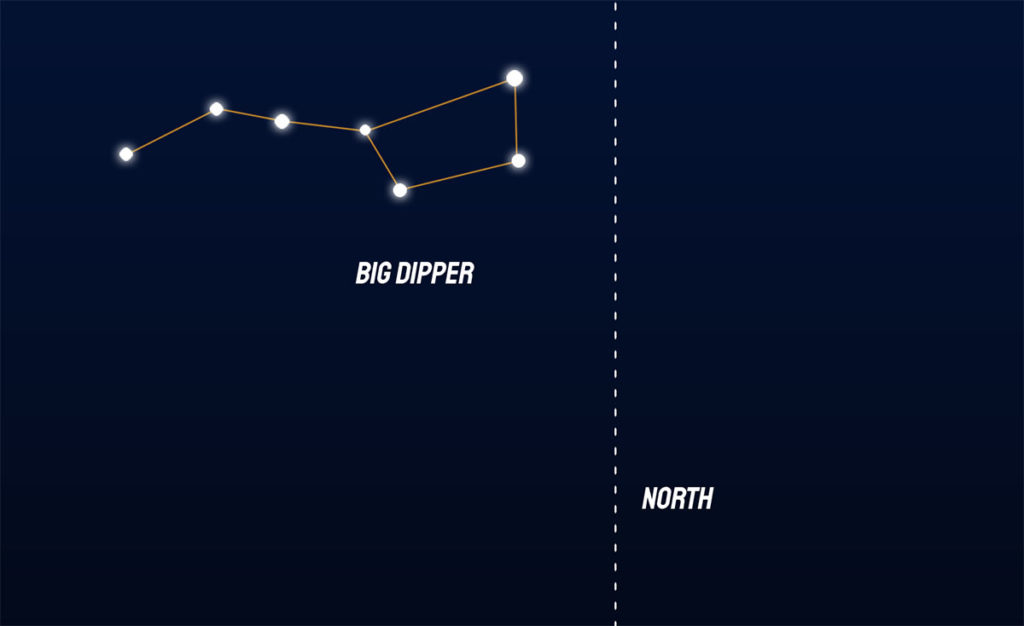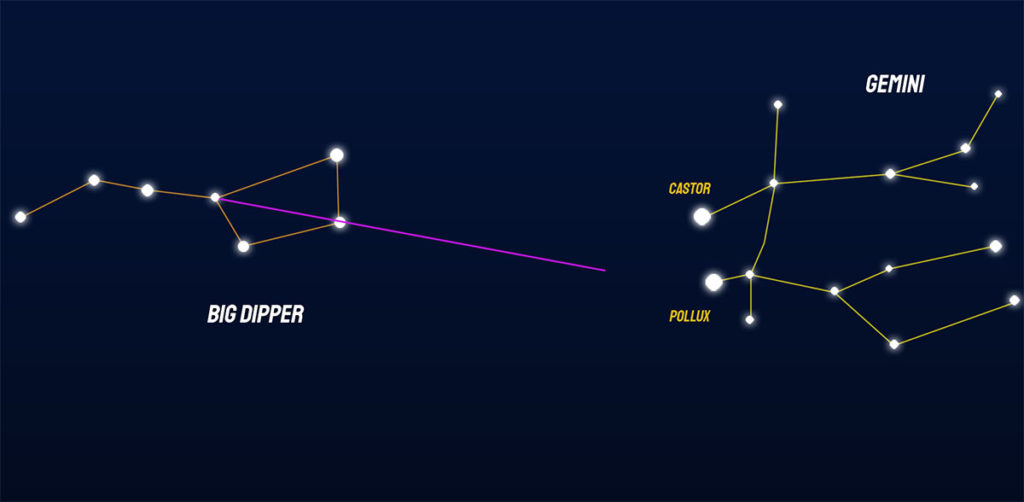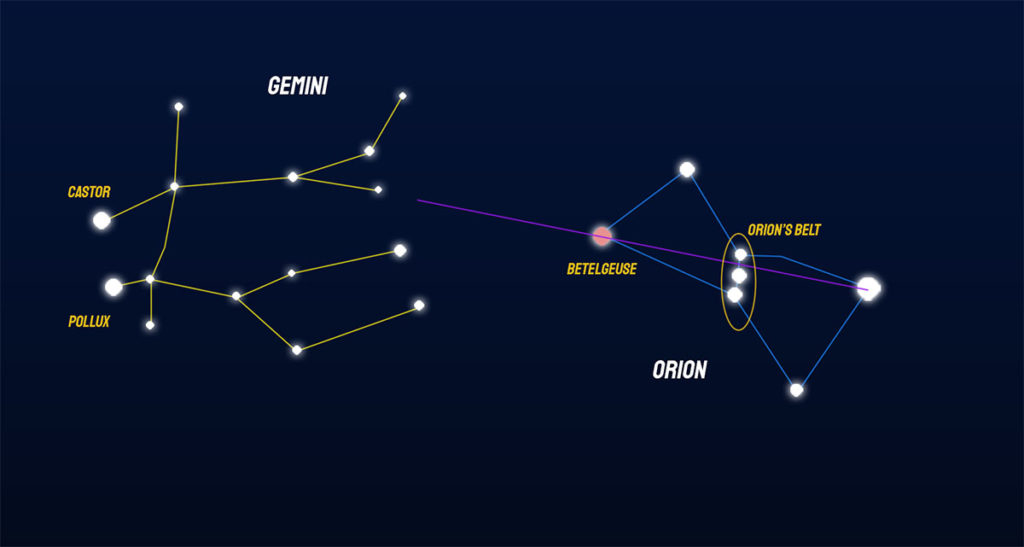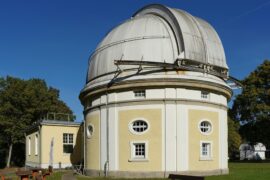The Gemini constellation is a group of stars that is recognized by the International Astronomical Union as one of the official 88 constellations that can be found in the night sky. It also forms part of the 12 zodiac constellations.
Finding Gemini in the night sky is a very simple process. It is one of the easiest to find zodiac constellations and there are multiple available methods to do so, so it’s possible to locate it anywhere in the world.
Here is a basic fact sheet about the Gemini constellation:
| Name | Gemini |
| Abbreviation | Gem |
| Genitive | Geminorum |
| Meaning | The twins |
| Main stars | 8 |
| Bayer stars | 80 |
| Discovered stars with planets | 8 |
| Brightest star | Pollux |
| Location | Quadrant NQ2 |
| Visible latitudes | +90 to -60 |
| Meteor showers | Geminids, Rhos Geminids |
| Neighboring constellations | Taurus, Orion, Cancer, Canis Minor, Linx |
When and where to find the Gemini constellation
Gemini can be found in the sky between September and May everywhere in the world, including the U.S., UK, and the rest of Europe. The best time to observe it is in February when it is directly overhead at around 9:00 PM.
During the Summer months, from June to August, Gemini cannot be seen as it passes behind the Sun.
Because of Earth’s orbit, constellations appear in the sky at different times on some months, but just like the Moon and the Sun, constellations also rise in the East and set in the West.
The following table details the times of the night when Gemini appears in the sky for each month and when it’s not possible to see it.
| Month | Visible | Not visible |
|---|---|---|
| January | 6:00 PM to 6:00 AM | 6:00 AM to sunrise |
| February | sunset to 4:00 AM | 4:00 AM to sunrise |
| March | sunset to 2:00 AM | 2:00 AM to sunrise |
| April | sunset to 1:00 AM | 1:00 AM to sunrise |
| May | sunset to 11:00 PM | 11:00 PM to sunrise |
| June | not visible | not visible |
| July | not visible | not visible |
| August | not visible | not visible |
| September | 2:30 AM to sunrise | sunset to 2:30 AM |
| October | 00:30 AM to sunrise | sunset to 00:30 AM |
| November | 9:30 PM to sunrise | sunset to 9:30 PM |
| December | 8:00 PM to sunrise | sunset to 8:00 PM |
For the months when it’s visible since sunset, you will not see rise from the East, but instead, it will already be up in the sky. You should still be able to find it in the eastern sky except for May when it appears already overhead at sunset.
Gemini is located in the NQ2 quadrant of the sky, which means it can be better seen from the Northern hemisphere and places around the equator.
This constellation is bright enough to be seen without help from a telescope even in big cities as long as the sky is clear. But like everything in the sky, it can be better appreciated from locations with low light pollution.
How to find the Gemini constellation
There are multiple methods to find Gemini in the sky. Here we will help you learn the two simplest ones. The first one works best in the Northern hemisphere while the second can be used anywhere in the world as long as Orion is visible.
Gemini, like all the other zodiac constellations, can be found in the ecliptic plane. This is the imaginary line that follows the path of Earth’s orbit around the Sun. A common method to find any of these twelve constellations is to simply find this line and go through the visible zodiac constellations until you reach the one you want. This is better explained in our article on how to find Aquarius.
Gemini is relatively easy to find thanks to the fact that it has many recognizable features, like Castor and Pollux (Alpha Geminorium and Beta Geminorium), two bright stars that are paired up near each other, and that are one of the reasons why this constellation is referred to as the twins.
Method 1 (Northern hemisphere)
Step 1: Find the Big Dipper
The Big Dipper isn’t really a constellation by itself. It is simply a common name given to a section of the Ursa Major constellation that really looks, well, like a dipper. It is really easy to find because of its position and shape, so many methods to find other constellations start with it.
The Big Dipper is almost aligned with the True North. So, in order to find it, all you simply need to do is to look North. If you have no idea which way is North, just use the compass app on your phone, or follow this guide.
Step 2: Find Castor and Pollux
Once you have identified the big dipper, trace an imaginary line from the “handle” to the star that makes up the opposite “bottom” of the dipper.
Extend this line across the site and it should point you right in the direction of Castor and Pollux.
Method 2 (Anywhere in the world)
Step 1: Find Orion
This method depends on Orion being visible in the sky. Orion can be found between August and April.
Orion is the easiest constellation to find in the sky. Simply look for 3 really bright stars close to each other in a straight line. They are hard to miss in a clear sky. This is Orion’s belt.
Once you have found Orion’s belt, for the next step, you are going to need to find which way is the “upper body” of Orion. For this, look around the belt and find an even brighter star that has a bit of a red tone. This is Betelgeuse, one of the brightest stars in the sky and it marks the upper left corner of Orion.
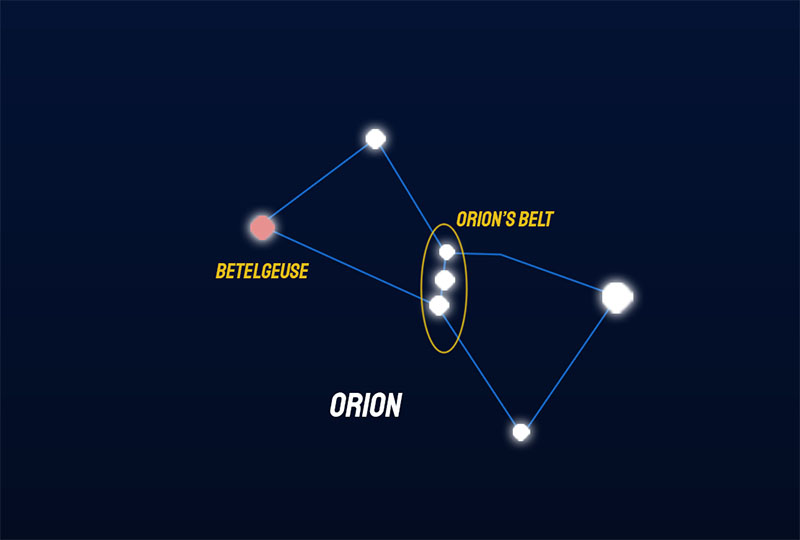
Step 2: Identify Castor and Pollux
Trace an imaginary line diagonally across Orion that ends at Betelgeuse. Extend this line and it will cross almost exactly between two bright stars. These are Castor and Pollux. This same line splits Gemini almost exactly in half, which makes it really easy to trace the rest of the constellation.
Identifying the shape of Gemini
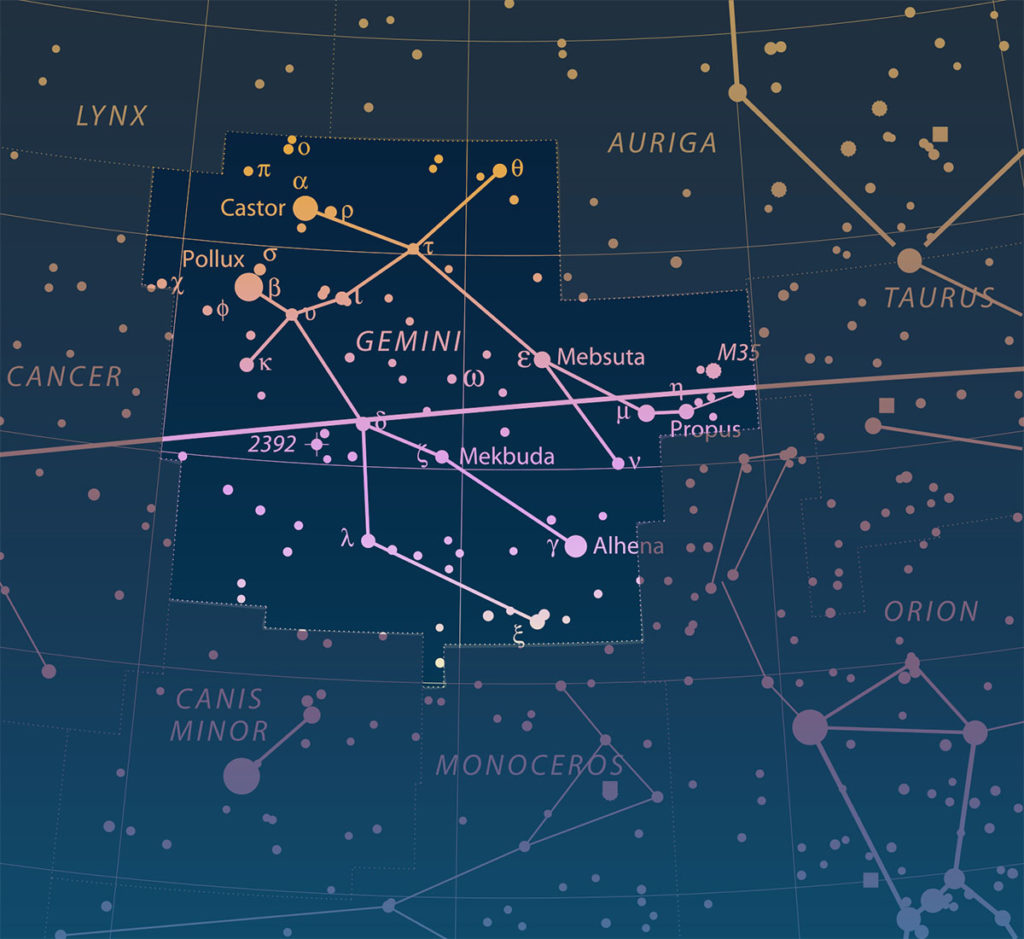
Gemini has two very bright stars paired up (it’s part of the reason why it’s called the twins). These are called Castor and Pollux and are easy to identify once you know the general area where they are located.
Once you have identified them, tracing the rest of Gemini is quite simple as it is very symmetrical.
The modern interpretation of the shape of the twins in Gemini uses 17 stars, while the classical interpretation uses 8 only. How many of these you can see is going to depend on the sky and weather conditions as not all of them are as bright as the two main stars.
Here are some guidelines that will help you:
- If you used the second method above, the “body” of the constellation is in the same direction as Orion.
- The third brightest star in Gemini, Alhena (Gamma Geminorium) delimits the lower left corner of Gemini, or the “leg” of the left twin.
- All the brighter stars in Gemini have an opposite at about the same distance compared to Castor and Pollux.
How to find more constellations
Aries – Taurus – Gemini – Cancer – Leo – Virgo – Libra – Scorpius – Saggitarius – Capricornus – Aquarius – Pisces
Enjoyed this article?
Get daily 10-minute PDFs about astronomy to read before bed!
Sign up for our upcoming micro-learning service where you will learn something new about space and beyond every day while winding down.


